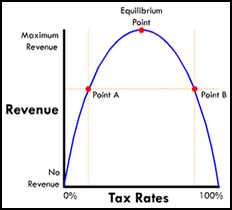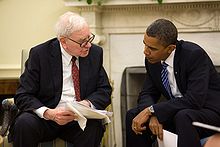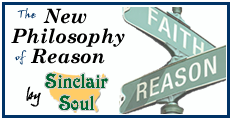Bell Curves and Societal Faith
May 17, 2012
By Sinclair Soul
 “We need to raise more taxes on the wealthiest Americans”
“We need to raise more taxes on the wealthiest Americans”
This is the oft-heard solution by populist politicians to solving many of the country’s fiscal woes and justification for implementing a new populist program. Unfortunately, it is just not that easy and this flip “solution” is usually more stagecraft than serious solution. Why? Because these proposals are to raise tax RATES which, in of itself does nothing to guarantee more REVENUE.
An actual model of how rates and revenues are connected (as well as several other cause/effect situations) would be a two-dimensional, x/y graph with plotted revenue forming a parabola or “bell curve”. The curve starts and begins at zero revenue, as a 0% rate would obviously bring in $0 in revenue and a 100% rate also bringing in $0 because (in a free society, at least) all incentive to work would be completely removed. So what we have in between is this parabola hill where revenues rise along with rates (the “up slope”) until reaching an apex of maximum revenue before declining (the “down slope”) once rates start to adversely effect the incentive to earn. This apex of the parabola, the point where revenue is maximized, has been called the equilibrium point by economist Art Laffer. So the $15 trillion question is this – what is the rate which brings us to this point of equilibrium. And a more generalized question would be, on which slope do we currently sit?
Some socialists believe that the “up” slope is elongated with the apex coming beyond 50% and then a steep drop off at some point higher than that. Many of us think this could only be true in a fascist or totalitarian society as no one in their right mind would work to their maximum potential to have more than half their earnings confiscated in a free society. In fact, revenue INCREASED significantly after the Reagan tax cuts in the 1980s and the Bush tax cuts of the early 2000s. This means we were on the “down slope” (beyond the equilibrium) of the bell curve before those policies were implemented.
 So where are we now? Right now the top rate is at about 35% and this is the rate that is spoken of in the “tax the rich” hyperbole, many saying we should bring it back to the 39.5% rate where it was under President Clinton. Another recent proposal by President Obama is the so-called “Buffet Rule”, which in theory would remedy the unfairness that billionaire Warren Buffet pays a lower rate than his Secretary by raising his taxes to a minimum level (isn’t funny how no one proposals lowering her level?) But, taking all the emotion out of this “fairness” issue, the question then becomes; would raising these rates bring in more revenue? And the answer is “probably”, if we were in a rational situation. But the situation today is far from rational.
So where are we now? Right now the top rate is at about 35% and this is the rate that is spoken of in the “tax the rich” hyperbole, many saying we should bring it back to the 39.5% rate where it was under President Clinton. Another recent proposal by President Obama is the so-called “Buffet Rule”, which in theory would remedy the unfairness that billionaire Warren Buffet pays a lower rate than his Secretary by raising his taxes to a minimum level (isn’t funny how no one proposals lowering her level?) But, taking all the emotion out of this “fairness” issue, the question then becomes; would raising these rates bring in more revenue? And the answer is “probably”, if we were in a rational situation. But the situation today is far from rational.
We currently have a national debt of over $15 trillion, which is up 150% from the $6 trillion debt just 7 years ago. Think about that, the national debt accrued in just the past 7 years is more than the debt accrued in the 230 years from 1776 to 2005! We are currently spending $1.5 trillion more than we take in each year and this is accelerating! This debt fact affects revenue more than any effective tax rate. Why? Because of a quiet yet extremely potent prime mover in economics – faith.
Most people don’t give a second thought to the societal faith we all have in normal daily situations. We traverse highways, bridges, and tunnels, fly on aircraft, and consume food, drink, and medicine without giving much thought to the deadly potential of each of these routine acts because we implicitly believe that most people do the competent and right thing. This is why 9/11 shook us to the core – not just the horror of the tragedy itself, but the way it damaged our collective faith (initially, at least – our rallying and coming together in the aftermath later reinforced our faith). Nowhere is this societal faith more important than in the world of economics.
We have implicit faith that a rectangular piece of printed paper is worth a certain value and, more importantly, that the value is backed up by a certain level of productive output. Without any deep thought or reflection, our minds can instantly conjure up the relative value of a given denomination – $20, $50, $100. $1000, etc. – and we can make near instant judgements and analysis on whether a certain product or service is worth the asking price and/or within our own personal budget. The looming crisis will be when this implicit faith is fractured, which very well may happen due to the exploding debt. Why? Because eventually there are only two real solutions to such an out-of-control problem like the debt and neither of these are good. The first one is to simply bail on our debt, which would shatter the faith of the rest of the world along with the millions of us bond holders in the U.S. This is not a good idea. The second solution is massive inflation, which will at once decrease the relative value of the debt but also destroy the implicit faith in the value of things that we all have.
 The Wiemar Republic was the new democratic government installed in Germany following World War I. It lasted for 14 years until it was dissolved by the evil Third Reich in 1933. Hyperinflation was so bad during these years that people would literally go shopping with wheel barrels full of money. Now, I’m not saying that it will get that bad here, but this does illustrate what could happen when debt gets out of control to the point where money descends to being just green paper with little value. And anyone who has been to the grocery store or gas pump knows we are heading in that undesirable direction. And if we ever get to the point where the vast amount of people lose faith in the dollar to the point where there is mass hoarding and bartering take over, the cascading decline may reach a point of no return. And then what?
The Wiemar Republic was the new democratic government installed in Germany following World War I. It lasted for 14 years until it was dissolved by the evil Third Reich in 1933. Hyperinflation was so bad during these years that people would literally go shopping with wheel barrels full of money. Now, I’m not saying that it will get that bad here, but this does illustrate what could happen when debt gets out of control to the point where money descends to being just green paper with little value. And anyone who has been to the grocery store or gas pump knows we are heading in that undesirable direction. And if we ever get to the point where the vast amount of people lose faith in the dollar to the point where there is mass hoarding and bartering take over, the cascading decline may reach a point of no return. And then what?
Finally, we return to the underlying cynicism of the political populists which multiplies the crisis for the short-term benefit of the few. While most of us can relate relative value of $20, $50, $100 or $1000, few of us in the “working class” can relate to the difference between $1 million, $1 billion, and $1 trillion. This vast economic ignorance of the public is preyed on by populists and socialists, starting at the top with President Obama who constantly groups “millionaires and billionaires” together. Think about it, grouping together millionaires and billionaires is exactly the same as grouping dimes and $100 bills! Now, imagine two families who put away their life savings in coffee cans – one filled with dimes and the other stuffed with $100 bills. Would anyone rationally think these are comparable? Of course not! But because a million dollars seems just as extravagant and unobtainable to many of us as a billion dollars, the President sees political opportunity in exploiting this misconception. (Much more on this in )
The simple truth is that we are in a very critical economic juncture in our country’s history and the vast amount of solutions to our problems can be solved with simple math. But unfortunately, political posturing is winning out over common sense and we’d better change soon, or we might find ourselves sliding down the wrong side of the bell curve.
~
 Sinclair Soul is a championship-level background singer, philosopher, and columnist for Big Blue Bullfrog. He specializes in examining the state of American culture from a “Soul” perspective.
Sinclair Soul is a championship-level background singer, philosopher, and columnist for Big Blue Bullfrog. He specializes in examining the state of American culture from a “Soul” perspective.

